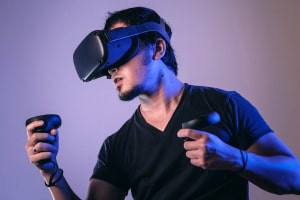Vision is a powerful sense and displays provide stimuli for the eyes so this course investigates their connection to the human visual system. We also cover haptics, the sense of touch that helps humans intuitively experience their immediate environment and use tools. We study the sense of touch as part of the body’s somatosensory system as we combine physiology, perception and engineering technology to create immersive virtual realities. This course teaches you the basic principles behind haptic rendering, tactile receptor types, the sensitivity threshold of mechanoreceptors and the kinesthetic system. We also show you various haptic devices that enable manual interaction with virtual environments while we explain how haptic feedback technology works.
The course then moves on to sound sources and attenuation. Developers of VR systems tend to focus mainly on vision because it is our strongest sense but the audio component of VR is powerful and technology that can bring high fidelity audio experiences into VR exists and sound is often crucial to art, entertainment and communication. This course unpacks the physics of sound in terms of waves, propagation and frequency analysis as hearing is an important sense for VR. We examine the physiology of human hearing and discuss the parts of the human ear and their function to help you understand auditory rendering, which can produce sounds synthetically from models or by reproducing captured sounds.
We then take a close look at VR systems and consider questions such as: ‘Which headset is better?’, ‘Which VR experience is more comfortable over a long period of time?’, ‘How many fields of view is enough?’ and ‘What is the most appropriate interaction mechanism?'. Engineers and developers crave answers to such questions but are hindered by the ways that human physiology and perception interact with engineered systems. We debate these questions and show you examples of perceptual training to demonstrate how you can create an experimental design to achieve realism. We introduce you to general motor learning and control, including manipulation, locomotion and ways in which users may interact with other objects in the virtual world. A background in computer science, electrical/mechanical engineering, neuroscience and psychology would be useful coming into this course. This course offers great opportunities to those interested in creating their own VR system or who want to learn how this cutting-edge technology creates compelling virtual experiences. VR could well be the ‘next Big Thing’ in terms of gaming, storytelling and education so sign up to ride the crest of the new wave.
What You Will Learn In This Free Course
View All Learning Outcomes View Less All Alison courses are free to enrol, study, and complete. To successfully complete this Diploma course and become an Alison Graduate, you need to achieve 80% or higher in each course assessment.
Once you have completed this Diploma course, you have the option to acquire an official Diploma, which is a great way to share your achievement with the world.
Your Alison certificate is:
- Ideal for sharing with potential employers.
- Great for your CV, professional social media profiles, and job applications.
- An indication of your commitment to continuously learn, upskill, and achieve high results.
- An incentive for you to continue empowering yourself through lifelong learning.
Alison offers 2 types of Diploma for completed Diploma courses:
- Digital Diploma: a downloadable Diploma in PDF format immediately available to you when you complete your purchase.
- Physical Diploma: a physical version of your officially branded and security-marked Diploma
All Diplomas are available to purchase through the Alison Shop. For more information on purchasing Alison Diploma, please visit our FAQs. If you decide not to purchase your Alison Diploma, you can still demonstrate your achievement by sharing your Learner Record or Learner Achievement Verification, both of which are accessible from your Account Settings.











 Avg. Hours
Avg. Hours  Contains Video
Contains Video  CPD Accredited
CPD Accredited 
 Total XP:
Total XP: 
 Knowledge & Skills You Will Learn
Knowledge & Skills You Will Learn 






